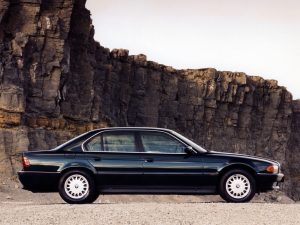Recalls: BMW E38 7-Series
Overview
Manufacturers, or importers, issue recalls for defects or faults which have the potential to cause injury. Generally, manufacturers will inform the original buyers if their vehicle is subject to a recall and of the steps required to remedy the defect or fault. Please note that the number of recalls should not be taken as an indicator of a model’s reliability or its safety more generally.
Recalls: BMW E38 7-Series
- In January 1996, a recall was issued for BMW E38 7-Series vehicles due to potential component failure in the rear axle hub carrier (PRA 1996/2696).
- In June 1996, a recall was issued for BMW E38 7-Series vehicles with M60 (3.0- and 4.0-litre V8) and M73 (5.4-litre V12) engines due to potential emissions from the hoses connecting the engine fuelling system to the fuel supply lines – this could result in a fuel smell coming from the engine compartment (PRA 1996/2855).
- In August 1996, a recall was issued for BMW E38 7-Series vehicles produced before February 1995. In these vehicles, the electric wire for the fuel pump may suffer damage, leaving the pump without power and leading to a sudden interruption to fuel supply (PRA 1996/2895).
- In October 2001, a recall was issued for BMW E38 7-Seriesvehicles due to a manufacturing problem with the auxiliary cooling fan electronics that could cause the fan to become thermally overloaded, reducing the cooling system’s performance and causing the engine to overheat (PRA 2001/5017).
Problems and faults: BMW E38 7-Series
Overview
This section identifies potential problems, causes and fixes based on the experiences of owners and repairers, online sources and technical service bulletins. This information is provided solely for reference purposes and AustralianCar.Reviews recommends that only properly qualified persons carry out repairs or modifications. Furthermore, the number of items below should not be taken as an indicator of a model’s reliability or the frequency with which they may occur.
To report a problem or fault to the AustralianCar.Reviews team, please use the Contact Us form. Note that AustralianCar.Reviews does not offer advice on automotive problems or disputes; such enquiries will not receive a reply. For vehicles purchased from dealers after 1 January 2011, please see our Australian Consumer Law fact sheet.
730iL and 740iL: M60 oil pump screws
- For the 730iL and 740iL with the M60 engine, the oil pump screws/bolts can become loose over time and fall into the lower oil pan. Symptoms of dislodged screws can include a ticking noise (sometimes mistaken for the lifters) or temporary illumination of the oil pressure light after hard braking (with a warning message in the instrument cluster) – the latter occurs when the oil pump is so loose that oil leaks out when it shifts forward.
735i, 735iL, 740i and 740iL: M62TUB35 and M62TUB44 VANOS failure
For the M62TUB35 and M62TUB44 engines, the VANOS unit may fail due to deterioration of the VANOS seals and symptoms include a rattling noise after cold starts (VANOS rattle), a clattering noise at idle once the engine has warmed up, a loss of bottom-end power and uneven power delivery. The VANOS seals comprise:
- An O-ring at the outer perimeter of the VANOS plastic housing; and,
- A dynamic rod seal at the inner perimeter of the same plastic housing.
Over time, the O-ring at the outer perimeter of the housing – made of Viton – experiences compression (flattening) and fails. Due to the sealed nature of the VANOS unit, the outer perimeter O-ring can’t be accessed and replaced. However, the VANOS top lip can be pressed down onto the plastic housing to, in turn, press the plastic housing down and set it on a VANOS wall shelf. This seating creates a functional oil seal that provides the oil chamber seal the O-ring was intended to achieve.
The plastic housing inner perimeter rod seal consists of a Teflon ring and backing O-ring; the Teflon ring is susceptible to wear and loss of material, causing it to lose its functional characteristics. Furthermore, the rod seal O-ring also experiences compression, exacerbating the effect of wear to the Teflon ring.
Problems and faults: BMW E38 7-Series
- Radiators are susceptible to failure around 80,000-90,000 kilometres.
- Whining or whirring noises from transmission may be due to replacement of the transmission fluid filter with a non-OEM product. The OEM filter should be labeled ‘FILTRAN’.
- The automatic transmission will malfunction, and eventually fail, if the wrong transmission fluid is used.
- The automatic transmission may not shift out of third gear if there is a difference in tyre sizes due to low air pressure or mismatched tyres.
- Catalytic converters require replacement at around 160,000 kilometres.
- If the front cupholder breaks, do not discard it since the replacement item does not include the wood trim finish.
- On older models, power steering hoses have a tendency to leak.
- If having the oil changed, it is worthwhile dropping the oil pan and checking for loose bolts on the oil pump – a loose bolt could make its way into the engine and destroy it.
- The oil warning light on the dashboard may illuminate due to a faulty oil pressure switch.
- Beyond 150,000 kilometres, front-end components such as the thrust arms, bushings and centre tie-rod likely require replacement.
- The xenon headlights may not illuminate if the switch is turned while cranking the engine.
- For models with V8 engines, oil and coolant may leak from the valley of the engine due to a leaking rear main seal.
- The power adjustable seats may stop working due to the chafing of wires underneath the seat.




